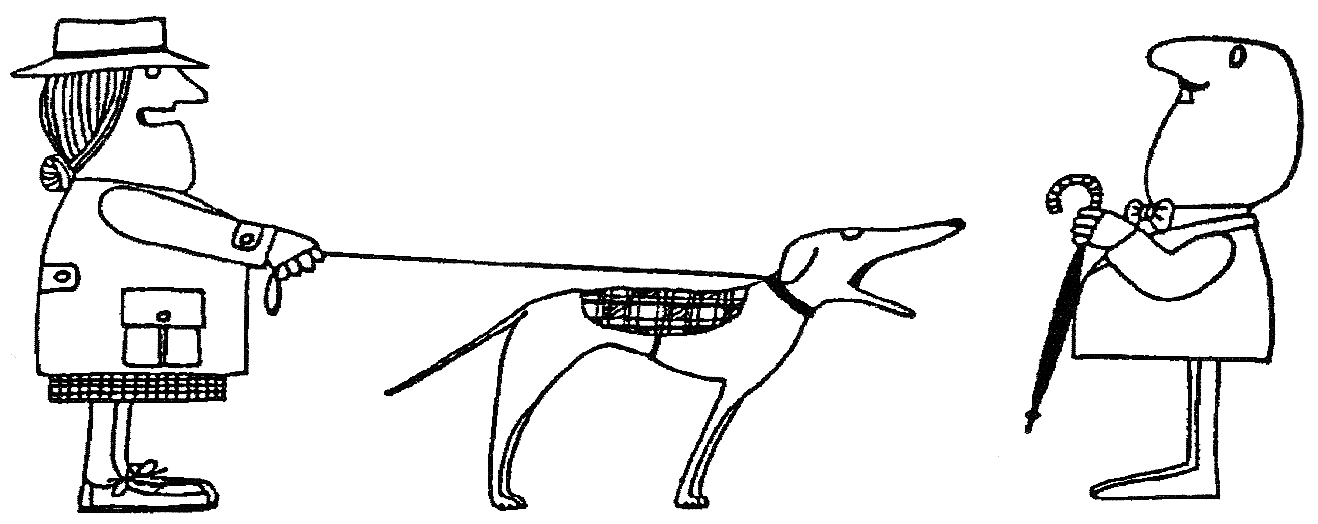|
So how do second language learners
- both those learning in a classroom and those in a naturalistic setting
- go about meeting the challenge of second language acquisition? In order
to answer this question, researchers in SLA have typically studied the
product of second language acquisition, in other words the language
that learners produce. Learner language studied in this way is referred
to as interlanguage, which implies both the language used and the
knowledge behind it. Reflective
task 2 presents some examples of interlanguage which display typical features.
Reflective task 2
|
The picture below was
used by SLA researchers to collect spoken data from both native
and non-native speakers.

- First of all, compare
an English native speaker's description of the picture and a non-native
speaker's description.
English native speaker
OK, there's a kind of fat old woman with a bun on (ah) on her
head, like towards the back of her neck, and she has a hat on
her head and she's got a checkered skirt on with some tennis shoes
and she's holding a leash to a dog who's barking at a bald man
with a moustache and a big nose who's wearing a bowtie and he's
got a black umbrella in his hand and the dog ...I don't know,
it's kind of like one of those big dogs, like, kind of, like a
greyhound, maybe, I don't know. And he's got, looks like a, not
really a saddle, but maybe a sweater or something on that's got
all these checkers, it's just on his back. And he's got a black
collar around his neck and ... the people's eyes are just circles,
they don't really have any pupils. And the man has a suit coat
on, a jacket type thing. And the woman's got her mouth open and
the man's mouth is shut.
English non-native speaker (L1 French)
Um. I see a man, a dog, and an no I see a woman, a dog and
another man. And ... the man uh look like Scottish man uhh ...
and uh (that is) and similarly between two mens um the dog um
want to bite the a-another man. Um.. The second man uhh has that
an umbrella. And um ... the woman is um as toward as the man.
The woman is speaking; the man don't speak. Um ... The ... the
dog is between the woman and the man. Ahh he look, it it look
uh angry. About the man. Um. I think the man don't appreciate
the dog. Um. I don't know if this woman know this man. Um Perhaps
they want to talk, but they have problem with this dog. Because
this dog is not quiet. And.. I'll stop.
- Now, study the transcriptions
of anglophone speakers' descriptions in either French, German
or Spanish. What features of these recordings mark them out, in
your view, as being produced by non-native speakers?
L2 French
Il y a une grande femme avec un chien. La femme porte un chapeau,
une robe et chaussures, je pense que la femme est vieux aussi.
Son chien est fâché et son chien ouvre son bouche. Il y a aussi
un homme, un homme avait peur du chien, et le homme porte une
....
L2 German
Wir haben eine picture mit zwei Leute und eine Hund und die
Frau hast eine Hund mit eine, uh fehlen dieses, ich weiss nich
dieses und der Hund ist (laughter) nah dem Mann. Und der Mann
hat einen ... on ... ich was .. ist der Mann hat. Der Mann sind
in der nahe der Hund und der Hund, oh jé, ich weiss nicht dieses.
Von der links ist eine Frau und die Frau hat einen Hut und nicht
in Seite, in Mitte ist einen Hund und rechts ist einen Mann. Und
das ist alles, ich kann nicht sehen alles.
L2 Spanish
Pués, hay una mujer con el perro y hay otra hombre ... ummm
.... La mujer lleva .. una sombrera umm una chaqueta y falda ...
zapatos... El pelo de la mujer umm es lacio ... El perro umm está
gritando al hombre. Y el perro lleva algo, pero yo no se qué es
... el hombre tiene una corbata pero no es larga; es ... umm ...
es .. muy corto, es un bowtie, y está trayendo una umm no recuerdo
la palabra, pero umm es para ... para la lluvia .. para no sacar
la lluvia y umm el hombre no tiene pantalones: es muy extrano,
no? No tiene zapatos también y umm el perro no le gusta al hombre,
en mi opinion. Y ... um la mujer tiene un umm leash ... no se
la palabra en espanol, pero umm el perro es suya no y suyo y ...
La mujer parecía como ella está diciendo algo pero no se ... Bueno
es todo.
(Reproduced from Sorace
et al, 1994)
|
Click on 'Commentary'
for feedback.
|
